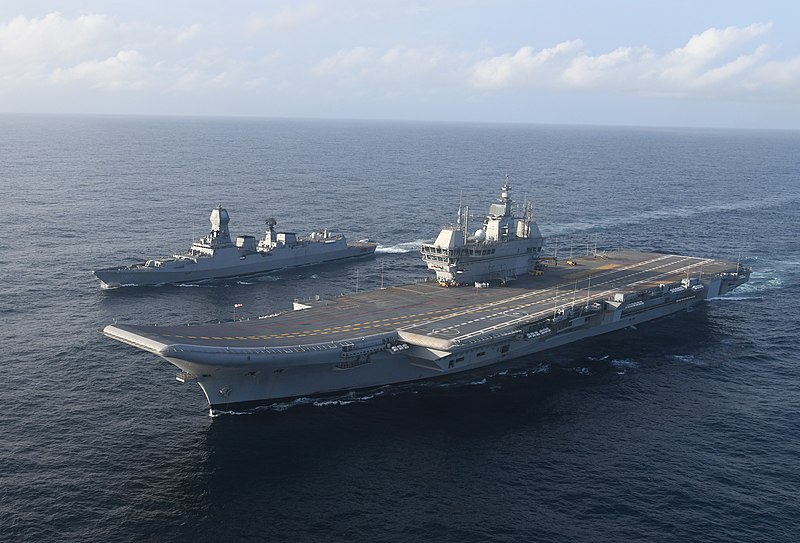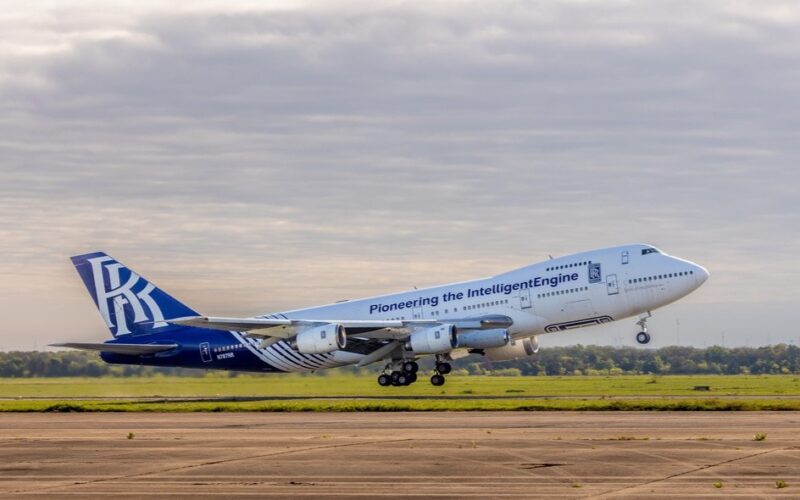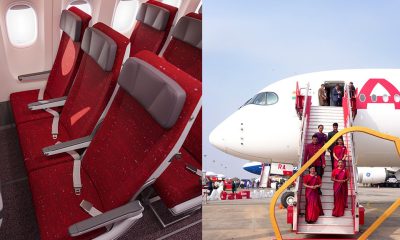Aerospace
7 Amazing facts to know about India’s first indigenous Aircraft Carrier
The brand-new navy aircraft carrier, INS Vikrant. Let’s explore some amazing details concerning the huge machine.

The brand-new navy aircraft carrier, INS Vikrant. Let’s explore some amazing details concerning the huge machine. Prime Minister Narendra Modi inaugurated the session where the Navy was given control of the massive aircraft carrier INS Vikrant, which joined the Indian Navy one day ago. Let’s learn more about this ship’s capabilities and why it is so crucial for protecting the Indian border.
It has 2,500 kilometers of cables
It generates enough electricity to run 5000 homes, and the wire will connect to Kashi from Kochi. there are 2,500 kilometers of cables. According to reports, IAC-1 contains 23,000 tonnes of steel, 150 kilometers of pipelines, 2,000 valves, and a variety of finished goods like rigid hull boats, galley equipment, air conditioning, refrigeration systems, and steering gear, indicating that more than 76% of the material and equipment on board is indigenous.
How many people worked in creating INS Vikrant?
According to reports, more than 50 companies directly employed almost 2,000 Indians each day on board IAC-1. Additionally, the project indirectly employed 40,000 people. Additionally, the approximately Rs 23,000 crore total project cost has been injected back into the Indian economy.
What is the INS Vikrant’s entire weight?
The new warship, which weighs 40,000 tonnes, is comparable to India’s present aircraft carrier, the INS Vikramaditya, which weighs 44,500 tonnes and can accommodate up to 34 aircraft, including fighter jets and helicopters. The battleship will be an unmatched military tool because of its ability to project Air Power over great distances.
What number of compartments did Vikrant have?
With 18 stories, INS Vikrant is referred to as a floating city. It has 14 decks and 2,300 compartments, which can hold about 1,500 sea warriors. The ship’s kitchen produces about 10,000 chapatis or rotis daily to meet the needs of the crew. The INS Vikrant has 2,400 compartments, 250 fuel tankers, and a 16-bed hospital.
What types of weapons can it hold?
With 32 Medium Range Surface-to-Air Missiles, Vikrant is armed (MRSAM). The Kavach anti-missile naval decoy system and AK 630 rotary cannons will also be installed on the aircraft carrier.
What types of aircraft will it transport?
The vessel has been built to fly “a variety of fixed wing and rotary aircraft,” according to the military ministry. In addition to the indigenously produced Advanced Light Helicopters (ALH) and the MH-60R multirole helicopter made by the American military firm Lockheed Martin, the MiG-29K fighter jet and Kamov-31 early warning helicopters developed in Russia will also be transported, according to the Navy. The largest ship ever constructed in Indian maritime history is the INS Vikrant. Its size is equivalent to two football fields.
What kind of INS is Vikrant using to power the enormous Fleet?
The new INS Vikrant, which is propelled by four 22 MW gas turbine engines, has a range of 7,500 nautical miles (about 13,900 km), which translates into an uninterrupted sea voyage from India to Brazil.

Aerospace
China Secures Production Certificate for Mass Production of Pilotless eVTOL Aircraft

The first passenger-carrying pilotless electric vertical takeoff and landing (eVTOL) aircraft in the world, the EH216-S, has received the Production Certificate for its eVTOL aircraft from the Civil Aviation Administration of China (CAAC).
This is a significant milestone for EHang Holdings Limited, the leading UAM technology platform company in the world. This outstanding accomplishment is another big step towards mass manufacturing for the eVTOL aircraft and the ensuing commercial operations, building on the ground-breaking acquisition of the Type Certificate and the Standard Airworthiness Certificate for the EH216-S.
The PC is a crucial certificate that the aircraft maker receives from the CAAC, the country’s aviation authority. By obtaining this certificate, EHang has demonstrated that it has set up a quality management system for mass production that satisfies the airworthiness regulation standards set forth by the CAAC, and the company has been given permission to continue producing mass quantities.
It is also a strong guarantee of the calibre of the goods made by EHang. Raw materials, supplier management, manufacturing organisation, production quality control, aircraft pre-delivery test, after-sales repair and maintenance, etc. are all included in the mass production quality management system for the EH216-S.
To ensure that every aircraft and its components that roll off the production line strictly adhere to the approved type design and safety requirements, the system sets clear guidelines and documentation for every step in the production procedure. This ensures comprehensive traceability and safety control.
Aerospace
Four Airbus A380 Superjumbos lined up to be scrapped

In a strategic move aimed at reclaiming valuable resources from the iconic Airbus A380 aircraft, VAS Aero Services and Dr. Peters Group have announced a significant collaboration.
This partnership marks a milestone in aviation logistics and aftermarket services, with four of these colossal planes slated for teardown and redistribution of used serviceable material (USM).
The venture between VAS Aero Services, renowned for its expertise in aircraft dismantlement, and Dr. Peters Group, a prominent Germany-based investment fund management firm, underscores a commitment to sustainable aviation practices. This isn’t their first foray into scrapping A380s; their successful partnership has already seen the dismantlement of these aircraft, making them pioneers in this niche.
Under the agreement, the latest consignment brings the tally to eight A380s entrusted to VAS by Dr. Peters Group. Managing Director Christian Mailly of Dr. Peters Group emphasized the trust placed in VAS, citing their unparalleled capabilities in dismantlement and aftermarket sales network. It’s a strategic move in response to the growing demand for quality USM parts, particularly with the resurgence in reliance on the A380.
Notably, the teardown process will be carried out at various locations, optimizing the positioning of harvested parts to cater to different markets. While some parts will be positioned in Europe to support operators in the region and the Middle East, others will remain in the Asia-Pacific region. This meticulous strategy ensures efficient access to spare parts, benefiting MROs and airlines across these markets.
The decision to retire these A380s comes at a time when operators are reassessing fleet strategies amidst evolving market dynamics. Despite initial plans for quick retirement due to the emergence of more fuel-efficient alternatives, factors such as a rebound in long-haul demand and delays in new widebody deliveries have prompted operators to reconsider. The A380, with its unique capacity and capabilities, presents a practical solution for short-term capacity management.
Aerospace
Rolls-Royce Launches Test Flights for Revolutionary Pearl 10X Engine

Rolls-Royce reports that the company’s dedicated Boeing 747 flying testbed has seen the successful start of the Pearl 10X, their newest aero engine designed for the business aviation industry.
Dassault, a French aircraft manufacturer, has decided to use this engine only to power their newest flagship, the Falcon 10X. As stated at last year’s Capital Markets Day, the commencement of flight testing represents a significant milestone for both Rolls-Royce and the Pearl 10X programme as the company concentrates on expanding in the business aviation industry.
The first Rolls-Royce engine to power a Dassault business jet is the Pearl 10X, the newest engine in the state-of-the-art Pearl engine family. The Pearl 10X was chosen by the French aircraft manufacturer as their new flagship model, demonstrating even more of Rolls-Royce’s dominance in the business aviation engine market.
Over the next few months, pilots and flight test engineers from Tucson, Arizona, USA, will put the engine through its paces. The flight test programme will comprise testing of the nacelle’s anti-icing system, in-flight relights, engine performance and handling checks at various speeds and altitudes, and fan vibration tests at various altitudes.
The new auxiliary gearbox, which enables higher additional power extraction, and the ultra-low emissions ALM combustor, which is compatible with 100% Sustainable Aviation Fuel (SAF), have undergone extensive testing as part of the ground-based development programme thus far. The engine will be the most potent business aviation engine in the Rolls-Royce lineup. It exceeded its intended thrust levels during the very first test run. With over 2,300 testing hours successfully completed on the Pearl 10X engine configuration as well as the Advance 2 demonstration, the programme is moving forward at a rapid pace.
With the most economical engine core available for business aircraft, the Advance2 engine, coupled with a high-performance low-pressure system, gives the Pearl 10X an exceptional thrust of over 18,000 lbf. With a 5% increase in economy over the previous generation of Rolls-Royce commercial aviation engines, the Pearl 10X





















